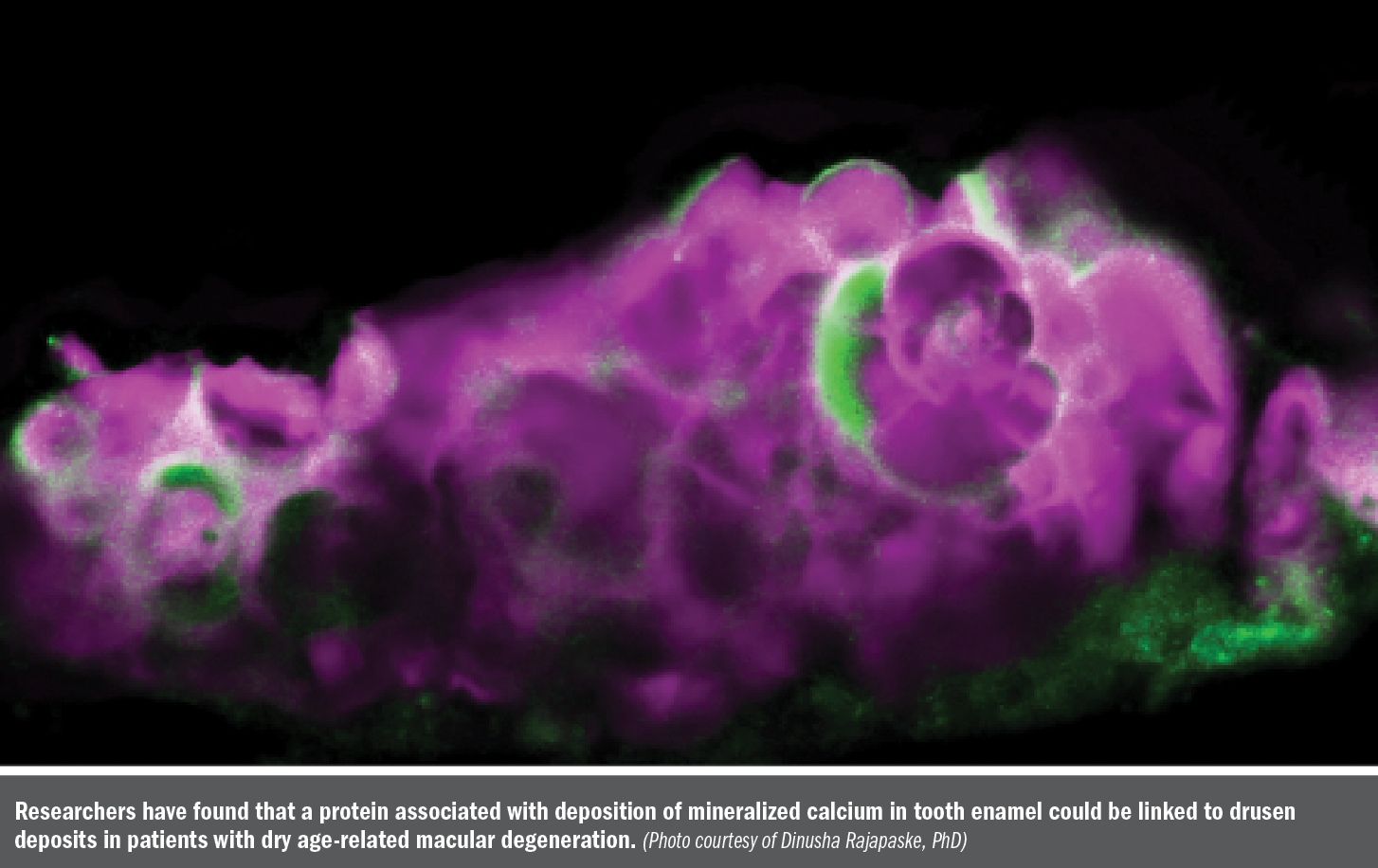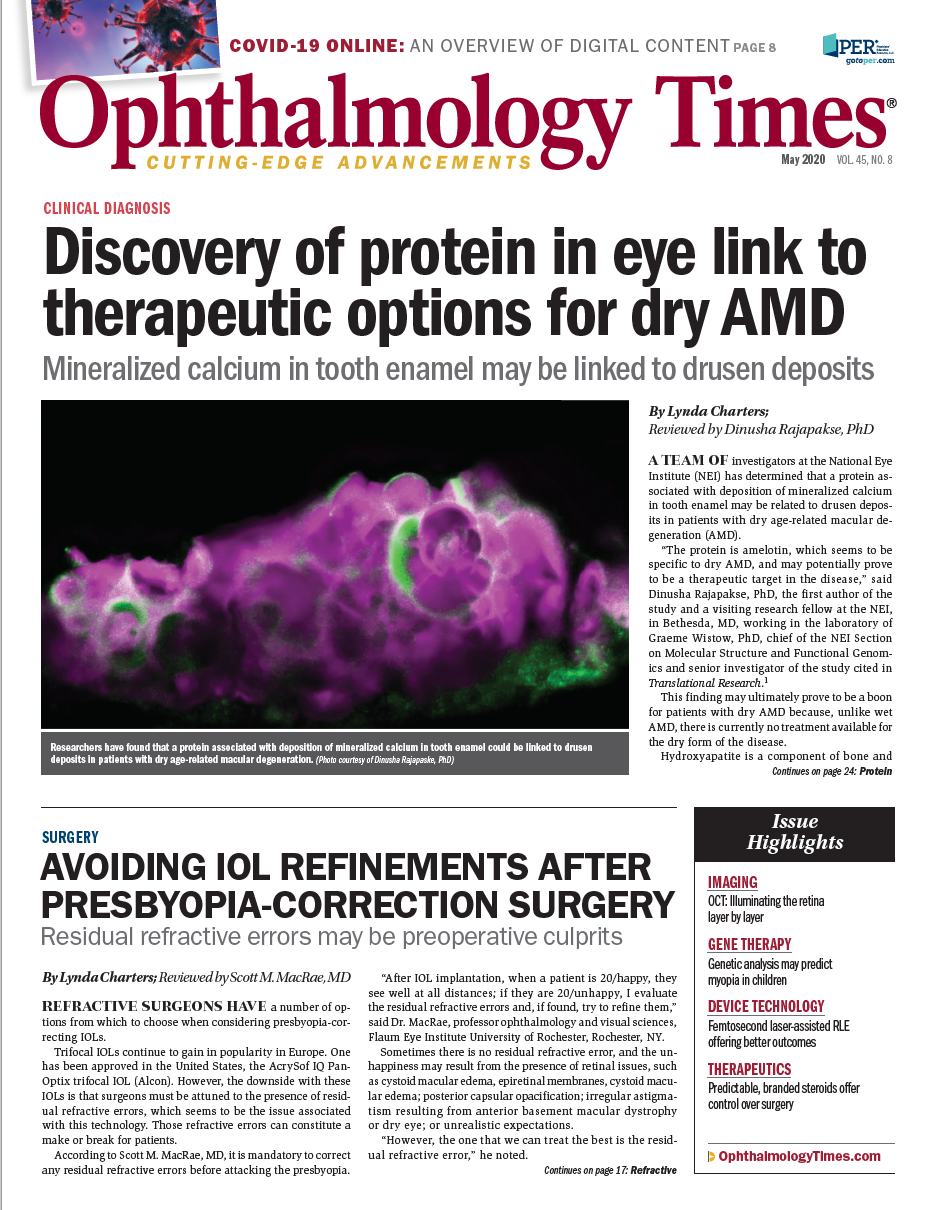Publication
Article
Digital Edition
Discovery of protein in eye link to therapeutic options for dry AMD
Author(s):

Mineralized calcium in tooth enamel may be linked to drusen deposits.
This article was reviewed by Dinusha Rajapakse, PhD
A team of investigators at the National Eye Institute (NEI) has determined that a protein associated with deposition of mineralized calcium in tooth enamel may be related to drusen deposits in patients with dry age-related macular degeneration (AMD).
“The protein is amelotin, which seems to be specific to dry AMD, and may potentially prove to be a therapeutic target in the disease,” said Dinusha Rajapakse, PhD, the first author of the study and a visiting research fellow at the NEI, in Bethesda, MD, working in the laboratory of Graeme Wistow, PhD, chief of the NEI Section on Molecular Structure and Functional Genomics and senior investigator of the study cited in Translational Research.1

Related: Risuteganib: Exploring novel dry AMD treatment
This finding may ultimately prove to be a boon for patients with dry AMD because, unlike wet AMD, there is currently no treatment available for the dry form of the disease.
Hydroxyapatite is a component of bone and tooth enamel. In their study, the investigators corroborated that hydroxyapatite, a calcium-rich mineral compound previously associated with AMD progression, is deposited in dry AMD.
Small spherules of hydroxyapatite filled with cholesterol were identified in drusen from patients with dry AMD.
In the study, when the retinal pigment epithelium (RPE) cells were starved of serum for 9 days, the investigators saw formation of amelotin deposits.
Dr. Rajapakse and colleagues reported that amelotin “was strongly upregulated after extended starvation and is responsible for the mineralization of [hydroxyapatite] in their cell culture model. Blocking this pathway in the RPE cell line also blocked the production of these drusen-like deposits.”
Related: DARP in molecule reducing wet AMD treatment burden for patients
The team also examined human cadaver eyes with dry AMD, wet AMD, or no AMD. Amelotin was only found in eyes with dry AMD. In these eyes, amelotin was sometimes found in areas of the RPE without drusen, but it was primarily present in soft drusen with large deposits of hydroxyapatite.
“Before this study, nobody really knew how hydroxyapatite was accumulating in dry AMD drusen,” said Dr. Rajapakse. “Finding this tooth-specific protein in the eye-the protein that is linked to hydroxyapatite deposition, that was really unexpected.”

Related: Study targets subretinal option for AMD treatment
The reason for hydroxyapatite deposition remains unknown, but Dr. Wistow speculated that it may be the result of a “protective mechanism gone awry.”
“It’s possible that these protein, lipid, and mineral deposits may help damaged RPE cells block blood vessels from growing into the retina, a problem that is one of the key features of wet AMD,” he said. “But when the mineral deposits get too extensive, they may also block nutrient flow to the RPE and photoreceptors, leading to retinal cell death.”
According to Dr. Wistow, mechanistically, amelotin looks like a key player for the formation of these very specific hydroxyapatite spherules.
“That’s what it does in the teeth, and here it is in the back of the eye,” he said.
Related: Oral therapy targets Stargardt, dry AMD
He pointed out that this underscores the need to develop drugs that can specifically block the function of amelotin in the eye, which may delay disease progression.
“But we won’t know until we try it,” Dr. Wistow said.
However, this cannot be done until animal models are developed to test new therapies for dry AMD. Dr. Wistow’s laboratory is currently in the process of developing a new murine model for dry AMD.
He also believes that the cell culture model, which mimics features of dry AMD, could potentially be useful for high throughput drug screening to find molecules that slow or prevent the development of soft drusen.
Read more by Lynda Charters
Dinusha Rajapakse, PhD
E: dinusha.rajapakse@nih.gove
Dr. Rajapakse has no financial interest in this subject matter.Graeme Wistow, PhD
E: graeme@helix.nih.gov
Dr. Wistow has no financial interest in this subject matter.
Disclosures:
Translational Research 2020. doi: 10.1016/j.trsl.2020.02.007.
Newsletter
Don’t miss out—get Ophthalmology Times updates on the latest clinical advancements and expert interviews, straight to your inbox.





